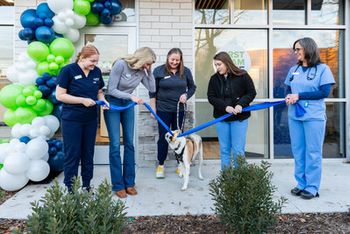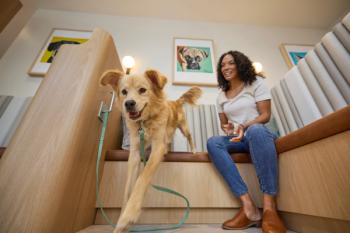
10 exam-room fixes
You don't have to redo your entire exam room to change the look and feel. Really, you don't. One of these 10 changes, each starting under $500, might just do the trick.
exam-room makeover
10 exam-room fixes
You don't have to redo your entire exam room to change the look and feel. Really, you donât. One of these 10 changes, each starting under $500, might just do the trick.
The bottom line
If you think your exam room looks worn out or out-of-date, your clients probably think so, too. But donât worry, one or two changes could drastically improve any exam room without emptying your wallet. Take a look at your door, walls, flooring, seating, cabinetry, and ceiling, and identify changes that would bring your room up to the standard of your care.
Do you ever look around your exam room and think, âItâs all got to go.â Youâre so fed up with the cluttered, â60s-style décor that youâd like to drive a bulldozer right through your practice and rip it out. Stop right there.
You can dramatically change the look of your room without uprooting your building or spending a fortune. To get you started, we asked an expert for advice. Wayne Usiak, AIA, Veterinary Economics Editorial Advisory Board member and senior partner with BDA Architecture in Albuquerque, N.M., offers these specific ways you can make a striking difference in the way your room looks by changing just one thing. And you can achieve many of the fixes for less than $500. (Of course bells and whistles cost more.) Take an unbiased look at your exam rooms and think about whether any of these strategies should go on your âmust-happen-nowâ list.
1. Clear the clutter
This exam-room makeover strategy is free. You just need to work those muscles enough to tote the extra knickknacks out. You could even delegate the job, so you donât have to sweat. Hereâs how to get started:âTake pictures of your room from a couple of different angles,â says Usiak. âBlow them up to 9 inches by 12 inches and print them out. Leave these pictures lying around for a few days, and youâll begin to see things you need to take out of the room.â For instance, stand-up advertisements, calendars, and anything else that sits on the counter week after week, he says. Make an offering to the circular file, and throw them away.
Next check out your walls. If itâs not in a frame, throw it away-or frame it fast. Usiak quotes board member Dr. Ross Clark on this one, âIf itâs good enough to put on your wall, itâs good enough to frame.â
2. Paint, paper, and trim.
Are your walls or trim outdated? Paint, paper, and trim can take your exam room from ughh to ahhh. Cost: Paint: $1 per square foot (if you hire a painter); wallpaper: $3 to $10 per square foot; chair rail: $1 per running foot; total: between $300 and $600 dollars
Think about the trim when you think about the paint, says Usiak. And consider adding a chair rail, crown molding to the ceiling, door casing, or base trim where the floor meets the walls.
If you install a chair rail, you can paint different colors above and below the rail, which would typically be between 30 and 42 inches high, says Usiak. Use dark colors below the chair rail and lighter colors above it. You could also paint one entire wall a darker color if you paint the other three walls a lighter color to keep the room from feeling closed in.
You could also wallpaper below the chair rail. âIf you go this route, use Type 2 Vinyl covering,â he says. âItâs washable, antimicrobial, and can stand the abuse of animals and scrubbing cycles,â he says. You donât have to pay a fortune for this update. Keep in mind, the more work you give a decorator or painter at one time, the lower the cost per square foot.
âRubber trim costs the least,â says Usiak, âand some extrusions look like wood moldings-these donât dent and you donât have to paint them.â Itâs a full time job keeping up to speed with available materials, so Usiak recommends hiring a creative designer who can search for materials.
3. Install new counter tops.
Cost: between $25 and $100 a running foot. âYou can really change the mood of an exam room just by changing the counter tops,â says Usiak. âAn average veterinary hospital exam room has less than 10 linear feet of counter top, so it costs between $250 and $1,000 total to change,â he says. You may be thinking that your counter tops are still in good condition. But if theyâre 15 years old, they probably look 15 years old. And if youâre tired of the colors and style, so are your clients.
4. Refresh your ceiling and lighting.
Cost: $3 per square foot to hang a new ceiling, and $150 per fixture. (Of course, you can always spend more.) Consider suspended acoustical tile for your ceiling and fairly common 2- foot by 4- foot lightfixtures that drop into the open space of a ceiling tile, says Usiak. Typical fluorescent lights can have a greenish-bluish tint, so he suggests you check out diffusers and color-corrected bulbs.
5. Redo your flooring.
Cost: $4 to $15 per square foot. âStick to neutral colors with flooring,â says Usiak, âYouâve got a lot more paint colors than floor colors to choose from, and you want a floor you can pair with a variety of shades.â
However, youâll still make many decisions about your flooring options. For example, vinyl sheet flooring lasts about 10 to 15 years, while youâll tire of your porcelain tile before you can wear it out. Perhaps not surprisingly, the longer-lasting option costs more.
6. Ditch the dingy door.
Cost: $300 to $1,000 installed. Do you have a worn out or ugly door-or one thatâs more than 20 years old? If so, replace it.
You have a lot of room for personalization here. For instance, do you want natural wood or a painted door, traditional styling or a raised panel door? âThere are nice wood doors you can stain and solid core doors you can paint-a solid core door is better for noise control,â says Usiak. âWhen you choose a door, you really need to balance maintenance and design. For example, a natural oak or birch door with a stain finish wonât show damage as much as a painted door.â
Keep in mind, thereâs more to your door than a hunk of wood. âThe hardware lockset that goes on it adds a design touch as well,â says Usiak. âAnd donât forget the frame and trim that go around the door. If the door is bad, the frame is probably worse.â
Mops and dog leashes bending around corners wreak havoc on both wood and metal doorframes. âSteel will rust over time, but wood generally shows the dirt more,â says Usiak. âYou can touch-up both up if you stay on top of cleaning and painting-the paint protects the metal from rusting.
âWood creates a warmer feel and I think it looks a little better. But metal is just more durable.â This is probably why about 85 percent of practices go with metal doorframes, Usiak says.
7. Add a window to the world-or to the inner workings of your practice.
Cost: $500 to $1,000 for an exterior window and less for an interior window. If your exam room has an exterior wall, a shared wall with a hallway, or a door, you can add a window.
âOnly 20 percent of hospitals have an outside wall,â says Usiak, âso an interior or door window is a great option.â A single pane of glass with a wood or metal frame and a set of blinds is the most cost-effective way to go. Though you do have the option of spending more and cleaning less if you buy windows with the blinds between the panes of glass.
âIf youâre buying a brand new door, think about the window now because it costs a lot less to buy it with the door-an addition of only $50 to $60,â says Usiak.
8. Install a ceiling fan.
Cost: $200 to $300. âCeiling fans make the room seem fresher and cooler,â says Usiak. âAnd as long as you have a ceiling light, you can replace it with a fan and a light. It can be as decorative as you like-traditional or contemporary-whatever works for you.â The only maintenance is wiping the blades off so that they donât gather dust.
9. Build in seating.
Cost: $200 to $1,000. âSeating can make a room more functional,â says Usiak, âand it can be simple or elaborate.â For example, built-in or upholstered-in benches with storage underneath add space. An indirect advantage: âWeâve found that some dogs use the seating to jump on the exam table; it gives them an intermediate point,â he says.
10. Replace your cabinetry.
âThink about how important kitchen cabinets are to how the room looks and feels-your exam room cabinets affect the room the same way,â says Usiak. âOf course, you could paint your cabinets, but remember, anything you paint, you need to repaint.â
Most practices choose plastic laminate cabinets because they wipe down easily, they donât discolor, and theyâre durable. Wood cabinets look nice, but only about 2 percent of practices use them because they tend to get oil stains where you open the doors frequently.
Newsletter
From exam room tips to practice management insights, get trusted veterinary news delivered straight to your inbox—subscribe to dvm360.




